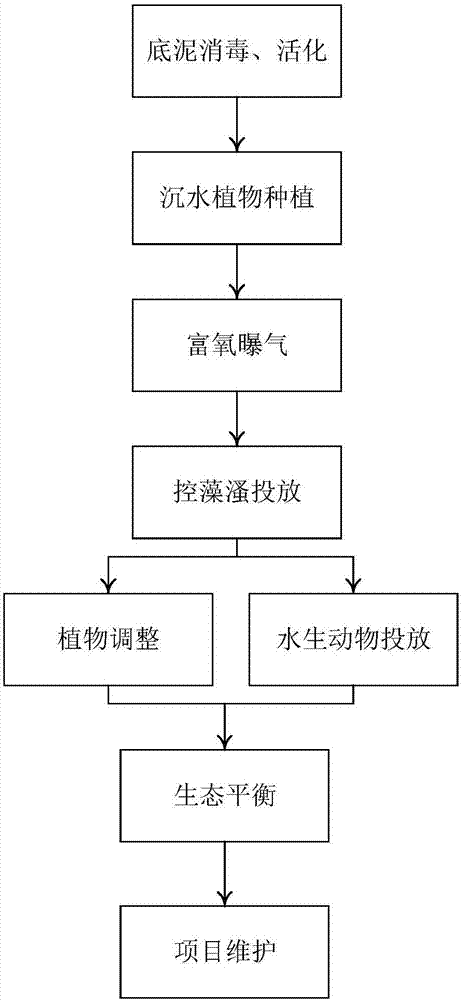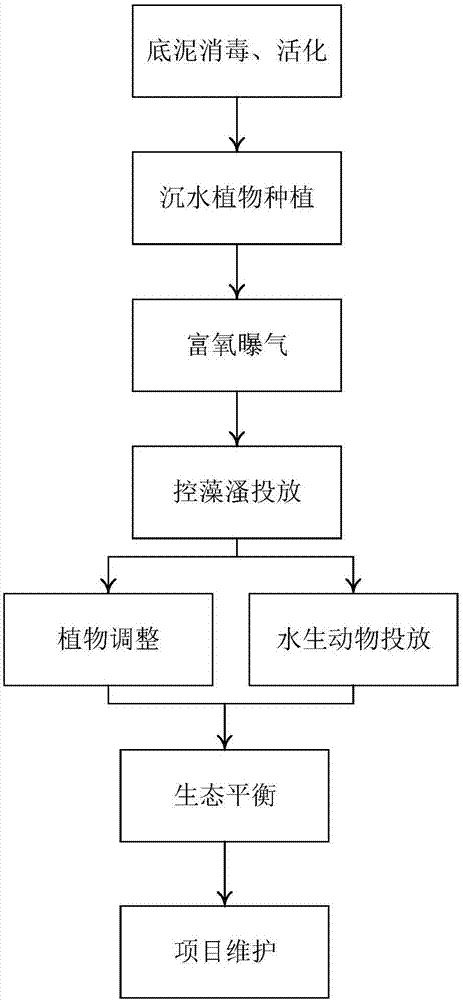Ecological restoration method for in-situ low-carbon submerged water in water body
A restoration method and water ecology technology, applied in chemical instruments and methods, biological water/sewage treatment, water/sludge/sewage treatment, etc., can solve the problem of high investment cost, large financial, manpower and material resources, and cure the symptoms but not the root cause and other issues, to achieve the effect of low cost and no need for a computer room
- Summary
- Abstract
- Description
- Claims
- Application Information
AI Technical Summary
Problems solved by technology
Method used
Image
Examples
Embodiment 1
[0026] An in-situ low-carbon submerged water ecological restoration method for water bodies, the method includes the following steps:
[0027] S1. Bottom sludge disinfection and activation: use Chinese herbal medicine disinfection activator with a concentration of 400mg / L, spray it evenly on the entire bottom of the pool, and use a dosage of 100ml / ㎡. After disinfection, let it stand for 30 minutes, and then activate the bottom sludge;
[0028] S2. Planting of submerged plants: Plant evergreen submerged plants in all seasons, with a planting density of 50 plants / ㎡ and a planting area of 20%;
[0029] S3. Temporary auxiliary oxygen-enriched aeration: Introduce high-concentration oxygen into the water, with an oxygen concentration of 90%, for 2 hours. While aerating, add sodium percarbonate solution to the water, with a concentration of 18%;
[0030] S4. Adding algae-controlling daphnia: measure the pH of the pool water before putting in algae-controlling daphnia, according to ...
Embodiment 2
[0039] An in-situ low-carbon submerged water ecological restoration method for water bodies, the method includes the following steps:
[0040] S1. Bottom sludge disinfection and activation: select Chinese herbal medicine disinfection activator with a concentration of 450mg / L, spray evenly on the entire bottom of the pool, and use a dosage of 110ml / ㎡. After disinfection and stand for 35 minutes, carry out bottom sludge activation;
[0041] S2. Planting of submerged plants: Plant evergreen submerged plants in all seasons, with a planting density of 55 plants / ㎡ and a planting area of 22%;
[0042] S3. Temporary auxiliary oxygen-enriched aeration: Introduce high-concentration oxygen into the water, with an oxygen concentration of 92.5%, for 2.5 hours. While aerating, add sodium percarbonate solution to the water, with a concentration of 19%;
[0043] S4. Adding algae-controlling daphnia: measure the pH of the pool water before putting in algae-controlling daphnia, according to t...
Embodiment 3
[0052] An in-situ low-carbon submerged water ecological restoration method for water bodies, the method includes the following steps:
[0053] S1. Bottom sludge disinfection and activation: select Chinese herbal medicine disinfection activator with a concentration of 500mg / L, spray it evenly on the entire bottom of the pool, and use a dosage of 120ml / ㎡. After disinfection, let it stand for 40 minutes, and then activate the bottom sludge;
[0054] S2. Planting of submerged plants: planting evergreen submerged plants in all seasons, the planting density is 60 plants / ㎡, and the planting area is 24%;
[0055] S3. Temporary auxiliary oxygen-enriched aeration: Introduce high-concentration oxygen into the water, with an oxygen concentration of 95%, for 3 hours. While aerating, add sodium percarbonate solution to the water, with a concentration of 20%;
[0056] S4. Adding algae-controlling daphnia: measure the pH of the pool water before adding algae-controlling daphnia, according to ...
PUM
 Login to View More
Login to View More Abstract
Description
Claims
Application Information
 Login to View More
Login to View More - Generate Ideas
- Intellectual Property
- Life Sciences
- Materials
- Tech Scout
- Unparalleled Data Quality
- Higher Quality Content
- 60% Fewer Hallucinations
Browse by: Latest US Patents, China's latest patents, Technical Efficacy Thesaurus, Application Domain, Technology Topic, Popular Technical Reports.
© 2025 PatSnap. All rights reserved.Legal|Privacy policy|Modern Slavery Act Transparency Statement|Sitemap|About US| Contact US: help@patsnap.com


